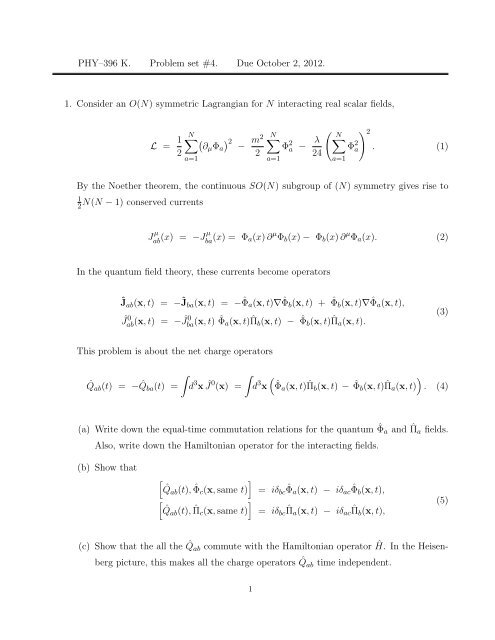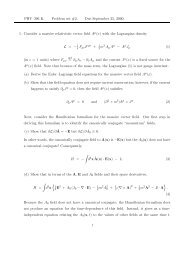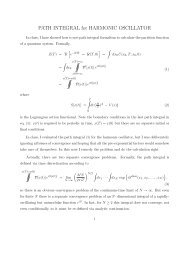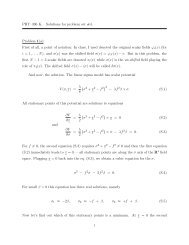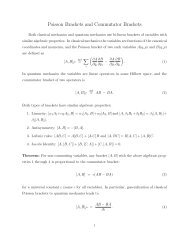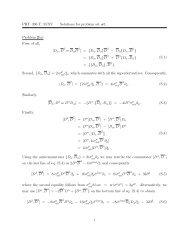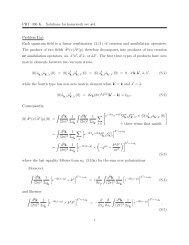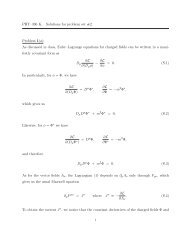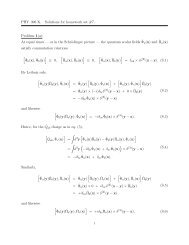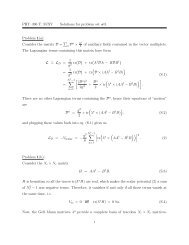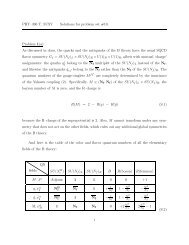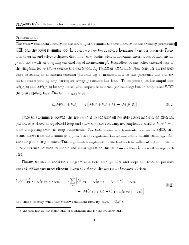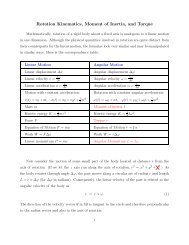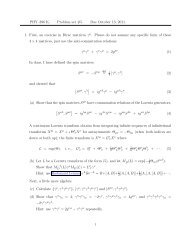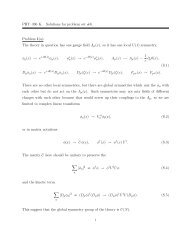PHYâ396 K. Problem set #4. Due October 2, 2012. 1. Consider an O ...
PHYâ396 K. Problem set #4. Due October 2, 2012. 1. Consider an O ...
PHYâ396 K. Problem set #4. Due October 2, 2012. 1. Consider an O ...
Create successful ePaper yourself
Turn your PDF publications into a flip-book with our unique Google optimized e-Paper software.
PHY–396 K. <strong>Problem</strong> <strong>set</strong> <strong>#4.</strong> <strong>Due</strong> <strong>October</strong> 2, <strong>2012.</strong><strong>1.</strong> <strong>Consider</strong> <strong>an</strong> O(N) symmetric Lagr<strong>an</strong>gi<strong>an</strong> for N interacting real scalar fields,L = 1 2N∑ ( ) 2 m 2∂µ Φ a −a=12(N∑Φ 2 a − λ N 2∑Φ 224a). (1)a=1a=1By the Noether theorem, the continuous SO(N) subgroup of (N) symmetry gives rise to12N(N − 1) conserved currentsJ µ ab (x) = −Jµ ba (x) = Φ a(x) ∂ µ Φ b (x) − Φ b (x) ∂ µ Φ a (x). (2)In the qu<strong>an</strong>tum field theory, these currents become operatorsĴ ab (x, t) = −Ĵ ba (x, t) = −ˆΦ a (x, t)∇ˆΦ b (x, t) + ˆΦ b (x, t)∇ˆΦ a (x, t),Ĵ 0 ab (x, t) = −Ĵ0 ba (x, t) ˆΦ a (x, t)ˆΠ b (x, t) − ˆΦ b (x, t)ˆΠ a (x, t).(3)This problem is about the net charge operators∫∫ˆQ ab (t) = − ˆQ ba (t) = d 3 x Ĵ0 (x) =d 3 x(ˆΦa (x, t)ˆΠ b (x, t) − ˆΦ)b (x, t)ˆΠ a (x, t) . (4)(a) Write down the equal-time commutation relations for the qu<strong>an</strong>tum ˆΦ a <strong>an</strong>d ˆΠ a fields.Also, write down the Hamiltoni<strong>an</strong> operator for the interacting fields.(b) Show that[ˆQab (t), ˆΦ c (x, same t)][ˆQab (t), ˆΠ c (x, same t)]= iδ bc ˆΦa (x, t) − iδ ac ˆΦb (x, t),= iδ bc ˆΠa (x, t) − iδ ac ˆΠb (x, t),(5)(c) Show that the all the ˆQ ab commute with the Hamiltoni<strong>an</strong> operator Ĥ. In the Heisenbergpicture, this makes all the charge operators ˆQ ab time independent.1
(d) Verify that the ˆQ ab obey commutation relations of the SO(N) generators,[ˆQab , ˆQ cd]= −iδ [c[b[ ˆQa]d] ≡ −iδ bc ˆQad + iδ ac ˆQbd + iδ bd ˆQac − iδ ad ˆQbc . (6)(e) In the Schrödinger picture ˆΦ a (x) <strong>an</strong>d ˆΠ a (x) c<strong>an</strong> be exp<strong>an</strong>ded into creation <strong>an</strong>d <strong>an</strong>nihilationoperators as if they were free fields. Show that in terms of creation <strong>an</strong>d<strong>an</strong>nihilation operators, the charges (4) becomeˆQ ab= ∑ p()−iâ † p,aâ p,b+ iâ † p,bâp,b . (7)Finally, for N = 2 the SO(2) symmetry is the phase symmetry of one complex fieldΦ = (Φ 1 + iΦ 2 )/ √ 2 <strong>an</strong>d its conjugate Φ ∗ = (Φ 1 − iΦ 2 )/ √ 2. In the Fock space, they giverise to particles <strong>an</strong>d <strong>an</strong>ti-particles of opposite charges.(f) Show that for N = 2ˆQ 21 = − ˆQ 12 = ˆN particles − ˆN <strong>an</strong>tiparticles = ∑ p(â † pâ p − ˆb † pˆb p)(8)whereâ p = âp,1 + iâ p,2√2are particle <strong>an</strong>nihilation operators,ˆbp = âp,1 − iâ p,2√2â † p = ↠p,1 − i↠p,2√2are <strong>an</strong>tiparticle <strong>an</strong>nihilation operators,are particle creation operators,(9)ˆb† p = ↠p,1 + i↠p,2√2are <strong>an</strong>tiparticle creation operators.2
2. Now consider a massive relativistic vector field A µ (x) with the Lagr<strong>an</strong>gi<strong>an</strong> densityL = − 1 4 F µνF µν + 1 2 m2 A µ A µ − A µ J µ (10)(in ¯h = c = 1 units) where the current J µ (x) is a fixed source for the A µ (x) field. Becauseof the mass term, the Lagr<strong>an</strong>gi<strong>an</strong> (10) is not gauge invari<strong>an</strong>t. However, we assume thatthe current J µ (x) is conserved, ∂ µ J µ (x) = 0.In <strong>an</strong> earlier homework (<strong>set</strong> 1, problem 1) we have derived the Euler–Lagr<strong>an</strong>ge equationsfor the massive vector field. In this problem, we develop the Hamiltoni<strong>an</strong> formalism forthe A µ (x). Our first step is to identify the c<strong>an</strong>onically conjugate “momentum” fields.(a) Show that ∂L/∂Ȧ = −E but ∂L/∂ ˙ A 0 ≡ 0.In other words, the c<strong>an</strong>onically conjugate field to A(x) is −E(x) but the A 0 (x) does nothave a c<strong>an</strong>onical conjugate! Consequently,∫ ()H = d 3 x −Ȧ(x) · E(x) − L . (11)(b) Show that in terms of the A, E, <strong>an</strong>d A 0 fields, <strong>an</strong>d their space derivatives,∫ { }H = d 3 x 12E 2 + A 0 (J 0 − ∇ · E) − 1 2 m2 A 2 0 + 1 2 (∇ × A)2 + 1 2 m2 A 2 − J · A .Because the A 0 field does not have a c<strong>an</strong>onical conjugate, the Hamiltoni<strong>an</strong> formalism doesnot produce <strong>an</strong> equation for the time-dependence of this field. Instead, it gives us a timeindependentequation relating the A 0 (x, t) to the values of other fields at the same time t.Specifically, we haveδHδA 0 (x) ≡∂H∂A 0∣ ∣∣∣x− ∇ ·(12)∂H∂(∇A 0 ) ∣ = 0. (13)xAt the same time, the vector fields A <strong>an</strong>d E satisfy the Hamiltoni<strong>an</strong> equations of motion,∂A(x, t) = −δH[ ]∂H∂t δE(x) ∣ ≡ −t∂E − ∇ ∂Hi,∂(∇ i E)(x,t)∂E(x, t) = +δH[ ](14)∂H∂t δA(x) ∣ ≡ +t∂A − ∇ ∂Hi.∂(∇ i A)(c) Write down the explicit form of all these equations.(x,t)3
(d) Verify that the equations you have just written down are equivalent to the relativisticEuler–Lagr<strong>an</strong>ge equations for the A µ (x), namely(∂ µ ∂ µ + m 2 )A ν = ∂ ν (∂ µ A µ ) + J ν (15)<strong>an</strong>d hence ∂ µ A µ (x) = 0 <strong>an</strong>d (∂ ν ∂ ν + m 2 )A µ = 0 when ∂ µ J µ ≡ 0, cf. homework #<strong>1.</strong>3. Next, let’s qu<strong>an</strong>tize the massive vector fields. Since classically the −E(x) fields are c<strong>an</strong>onicallyconjugate momenta to the A(x) fields, the corresponding qu<strong>an</strong>tum fields Ê(x) <strong>an</strong>dÂ(x) satisfy the c<strong>an</strong>onical equal-time commutation relations[Âi(x, t), Âj(y, t)] = 0,[Êi(x, t), Êj(y, t)] = 0,(16)[Âi(x, t), Êj(y, t)] = −iδ ij δ (3) (x − y)(in the ¯h = c = 1 units). The currents also become qu<strong>an</strong>tum fields Ĵµ (x, t), but theyare composed of some kind of charged degrees of freedom rather th<strong>an</strong> the vector fieldsin question. Consequently, at equal times the currents Ĵµ (x, t) commute with both theÊ(y, t) <strong>an</strong>d the Â(y, t) fields.The classical A 0 (x, t) field does not have a c<strong>an</strong>onical conjugate <strong>an</strong>d its equation of motiondoes not involve time derivatives. In the qu<strong>an</strong>tum theory, Â 0 (x, t) satisfies a similar timeindependentconstraintm 2 Â 0 (x, t) = Ĵ0 (x, t) − ∇ · Ê(x, t), (17)but from the Hilbert space point of view this is <strong>an</strong> operatorial identity rather th<strong>an</strong> <strong>an</strong>equation of motion. Consequently, the commutation relations of the scalar potential fieldfollow from eqs. (16); in particular, at equal times the Â0 (x, t) commutes with the Ê(y, t)but does not commute with the Â(y, t). 4
Finally, the Hamiltoni<strong>an</strong> operator follows from the classical eq. (12), namely∫ {)(Ĥ = d 3 1x 2 Ê 2 +(Ĵ0 Â) }2 Â0 − ∇ · Ê −2 1m2  2 0 + 1 2∇ × +12m 2  2 − Ĵ · Â∫ {= d 3 1x 2 Ê 2 + 1) 2 ((Ĵ0 Â) }22m 2 − ∇ · Ê +12∇ × +12m 2  2 − Ĵ · Âwhere the second line follows from the first <strong>an</strong>d eq. (17).Your task is to calculate the commutators [Âi(x, t), Ĥ] <strong>an</strong>d [Êi(x, t), Ĥ] <strong>an</strong>d write downthe Heisenberg equations for the qu<strong>an</strong>tum vector fields. Make sure those equations aresimilar to the Hamilton equations for the classical fields.(18)5


